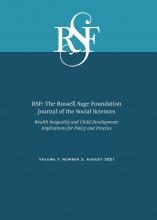Research Article
Open Access
Household Wealth and Child Body Mass Index: Patterns and Mechanisms
Courtney Boen, Lisa A. Keister, Nick Graetz
RSF: The Russell Sage Foundation Journal of the Social Sciences August 2021, 7 (3) 80-100; DOI: https://doi.org/10.7758/RSF.2021.7.3.04
Courtney Boen
aAssistant professor of sociology, research associate in the Population Studies Center and Population Aging Research Center, and senior fellow at the Leonard Davis Institute at the University of Pennsylvania, United States
Lisa A. Keister
bProfessor in the Department of Sociology and Sanford School of Public Policy and faculty research scholar of the Duke University Population Research Institute at Duke University, United States
Nick Graetz
cPhD candidate in demography and sociology in the Population Studies Center at the University of Pennsylvania, United States

REFERENCES
- ↵
- Assari, Shervin
- ↵
- ↵
- Boen, Courtney
- ↵
- Boen, Courtney
- ↵
- Boen, Courtney,
- Lisa A. Keister, and
- Brian Aronson
- ↵
- Boen, Courtney, and
- Y. Claire Yang
- ↵
- Bond Huie, Stephanie A.,
- Patrick M. Krueger,
- Richard G. Rogers, and
- Robert A. Hummer
- ↵
- Boshara, Ray,
- William R. Emmons, and
- Bryan J. Noeth
- ↵
- Bronfenbrenner, Urie, and
- Stephen J. Ceci
- ↵
- Case, Anne,
- Darren Lubotsky, and
- Christina Paxson
- ↵
- ↵
- ↵
- Currie, Janet, and
- Mark Stabile
- ↵
- Darity, William A., Jr.., and
- A. Kirsten Mullen
- ↵
- Deaton, Angus S., and
- Christina H. Paxson
- ↵
- Erixson, Oscar
- ↵
- ↵
- Gaydosh, Lauren,
- Kristen M. Schorpp,
- Edith Chen,
- Gregory E. Miller, and
- Kathleen Mullan Harris
- ↵
- ↵
- ↵
- ↵
- ↵
- Isong, Inyang A.,
- Sowmya R. Rao,
- Marie-Abèle Bind,
- Mauricio Avendaño,
- Ichiro Kawachi, and
- Tracy K. Richmond
- ↵
- Keil, Alexander P.,
- Jessie K. Edwards,
- David R. Richardson,
- Ashley I. Naimi, and
- Stephen R. Cole
- ↵
- ↵
- Killewald, Alexandra,
- Fabian T. Pfeffer, and
- Jared N. Schachner
- ↵
- Kochnar, Rakesh, and
- Anthony Cilluffo
- ↵
- Kuh, Diana,
- Yoav Ben-Shlomo,
- John Lynch,
- Johan Hallqvist, and
- Chris Power
- ↵
- Larson, Kandyce, and
- Neal Halfon
- ↵
- ↵
- ↵
- McCurdy, Karen,
- Kathleen S. Gorman, and
- Elizabeth Metallinos-Katsaras
- ↵
- ↵
- Oliver, Melvin, and
- Thomas Shapiro
- ↵
- Park, Min Hae,
- Catherine Falconer,
- Russell Viner, and
- Sanjay Kinra
- ↵
- Pearlin, Leonard I
- ↵
- Pearlin, Leonard I.,
- Joseph T. Mullan,
- Shirley J. Semple, and
- Marilyn M. Skaff
- ↵
- ↵
- Piketty, Thomas
- ↵
- Pollack, Craig E.,
- Sekai Chideya,
- Catherine Cubbin,
- Brie Williams,
- Mercedes Dekker, and
- Paula Braveman
- ↵
- Powell, Lisa M., and
- Yanjun Bao
- ↵
- Raudenbush, Stephen W., and
- Anthony S. Bryk
- ↵
- Reilly, John J.,
- E. Methven,
- Zoe C. McDowell,
- Belinda Hacking,
- D. Alexander,
- Laura Stewart, and
- Christopher J. H. Kelnar
- ↵
- ↵
- Scott, Karen A.,
- Susan J. Melhorn, and
- Randall R. Sakai
- ↵
- ↵
- Spilerman, Seymour
- ↵
- ↵
- Tate, Eleanor B.,
- Wendy Wood,
- Yue Liao, and
- Genevieve F. Dunton
- ↵
- van Buuren, Stef, and
- Karin Groothuis-Oudshoorn
- ↵
- ↵
- Yang, Y. Claire,
- Karen Gerken,
- Kristen Schorpp,
- Courtney Boen, and
- Kathleen Mullan Harris
In this issue
Household Wealth and Child Body Mass Index: Patterns and Mechanisms
Courtney Boen, Lisa A. Keister, Nick Graetz
RSF: The Russell Sage Foundation Journal of the Social Sciences Aug 2021, 7 (3) 80-100; DOI: 10.7758/RSF.2021.7.3.04
Jump to section
Related Articles
- No related articles found.
Cited By...
- No citing articles found.





